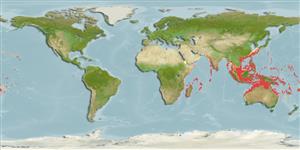分类 / Names
俗名 | 同种异名 | Catalog of Fishes(属, 种) | ITIS | CoL | WoRMS | Cloffa
Environment: milieu / climate zone / depth range / distribution range
生态学
海洋 礁区鱼类; 非迁移的; 深度上下限 10 - 150 m (Ref. 9710), usually 20 - 150 m (Ref. 9710). 熱帶; 34°N - 32°S, 31°E - 158°W (Ref. 5222)
Indo-Pacific: east coast of Africa (Djibouti, Socotra to Durban) to the Line Islands, north to southern Japan, south to southern Queensland (Australia). Not found at the Chagos Archipelago despite intensive survey and not reported from the Red Sea and Persian Gulf.
印度-太平洋: 非洲東岸 (吉布地 , Socotra 到德爾班) 到列島群島, 北至日本南部, 南至昆士蘭南部 (澳洲). 不在乎記錄自而不是的紅海與波斯灣的密集的調查不發現於查戈斯群島。
Length at first maturity / 大小 / 重量 / 年龄
Maturity: Lm ?, range 28 - ? cm
Max length : 57.0 cm TL 雄鱼/尚未辨别雌雄; (Ref. 5222); common length : 30.0 cm TL 雄鱼/尚未辨别雌雄; (Ref. 5450)
背棘 (总数) : 9; 背的软条 (总数) : 14 - 16; 臀棘: 3; 臀鳍软条: 9. This species is distinguished by the following characters: body depth greater than or subequal to head length, 2.3-2.7 times in standard length (for specimens 9-41 cm SL); dorsal head profile of adults straight to concave, the nape distinctly convex; pectoral fins subequal to pelvic fins, 1.5-1.7 times in head length for specimens of 15-40 cm length (in specimens larger than 40 cm, the pelvic fins are longer than the pectoral fins); pelvic fins reaching to or beyond anus; ctenoid body scales, cycloid on abdomen. Colour: Adults from Pacific Ocean generally pale reddish to yellowish brown, covered with numerous small brownish red or dark brown spots on head, body, and fins; while the juveniles are dark reddish brown to nearly black, the rear margin of caudal fin and sometimes pectoral fins whitish; or body brownish orange with scattered pale greenish spots, and black spot between upper and middle opercular spines (Ref. 39231, 90102).
鳃盖棘非常小的。 通常被达到或延伸超过肛门的腹鳍。 成鱼在印度洋的颜色: 身体橘红色的到红褐色的, 时常有分散的小微白色的斑块; 头部带紫色的到红褐色的有很多的靠拢在一起橘红色的斑点; 在低的 2根鳃盖棘之间的薄膜通常比其余的头部颜色更深; 鳍通常比身体, esp 颜色更深。 尾鳍与背鳍与臀鳍的较后面的部分; 腹鳍时常黑色的末梢部地。 成鱼在太平洋的颜色: 淡的淡红对土黄色在头部,身体与鳍上有很多的小红褐色的斑点。 尾鳍圆的。
Adults occur in deep lagoon reefs and steep outer reef slopes and in coastal areas with rocky substrates. Juveniles are usually found near sponges or coral heads (Ref. 9710). Adults usually at moderate depths with bommies with large holes, usually occupied by cleaner shrimps (Ref. 48635). They are solitary (Ref. 90102) and are usually caught in depths of 30 to 100 m, but in Madagascar, they occur in depths of 10 to 20 m. They feed on small fishes and crustaceans including shrimps, crabs and stomatopods (Ref. 37816). Females mature at about 28 cm SL and males at about 34 cm SL (Ref. 6448). Are sold in Hong Kong live fish markets (Ref. 27253). They are generally marketed fresh (Ref. 5284) and of commercial importance throughout most of its range. They are primarily caught with hook-and-line, spear, and in traps (Ref. 39231).
出现于深的泻湖礁与陡峭的外礁斜坡; 在沿岸区域见到有岩石的底部。 稚鱼通常在海绵或珊瑚顶部的附近被发现。 (参考文献 9710) 成鱼通常在深度中等之处有 bommies 和大洞穴的地方, 通常被清洁虾占领.(参考文献 48635) 通常在深度捕获了 30 到 100 公尺,但是在马达加斯加,它出现于对 20 公尺的深度 10 中。 吃包括虾,螃蟹与口足目甲壳类的小鱼与甲壳动物。 (参考文献 37816) 雌性在大约 28 公分 SL 时成熟而且雄性于大约 34 公分 SL 。 (参考文献 6448) 通常在市场上销售生鲜地了。 (参考文献 5284) 在香港活鱼贩售。 (参考文献 27253)
Life cycle and mating behavior
Maturities | 繁殖 | Spawnings | Egg(s) | Fecundities | 仔鱼
印度-太平洋: 非洲東岸 (吉布地 , Socotra 到德爾班) 到列島群島, 北至日本南部, 南至昆士蘭南部 (澳洲). 不在乎記錄自而不是的紅海與波斯灣的密集的調查不發現於查戈斯群島。
Heemstra, P.C. and J.E. Randall, 1993. FAO Species Catalogue. Vol. 16. Groupers of the world (family Serranidae, subfamily Epinephelinae). An annotated and illustrated catalogue of the grouper, rockcod, hind, coral grouper and lyretail species known to date. Rome: FAO. FAO Fish. Synop. 125(16):382 p. (Ref. 5222)
人类利用
渔业: 商业性
工具
特别资料
下载 XML
网络资源
Estimates based on models
Preferred temperature (Ref.
123201): 21.2 - 29, mean 27.6 °C (based on 2728 cells).
Phylogenetic diversity index (Ref.
82804): PD
50 = 0.5000 [Uniqueness, from 0.5 = low to 2.0 = high].
Bayesian length-weight: a=0.01318 (0.01062 - 0.01636), b=3.05 (3.02 - 3.08), in cm total length, based on LWR estimates for this species (Ref.
93245).
营养阶层 (Ref.
69278): 3.8 ±0.54 se; based on food items.
回复力 (Ref.
120179): 中等的, 族群倍增时间最少 1.4 - 4.4年 (Fec = 42,252).
Fishing Vulnerability (Ref.
59153): Moderate vulnerability (43 of 100).
Nutrients (Ref.
124155): Calcium = 36.1 [19.1, 59.7] mg/100g; Iron = 0.452 [0.251, 0.846] mg/100g; Protein = 18.5 [16.7, 20.2] %; Omega3 = 0.164 [0.103, 0.266] g/100g; Selenium = 50.5 [26.0, 86.5] μg/100g; VitaminA = 84.2 [31.1, 255.9] μg/100g; Zinc = 0.812 [0.561, 1.304] mg/100g (wet weight); based on
nutrient studies.
